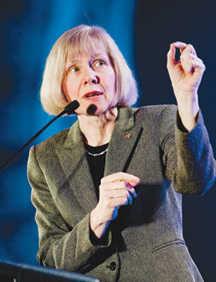Related story:
A key member of the team conducting the first FDA-approved clinical trial of stem cell transplants for ALS told a 2010 World Stem Cell Summit audience last week that none of the first six patients who received the treatment suffered serious complications.
U-M neurologist Dr. Eva Feldman, director of the A. Alfred Taubman Medical Research Institute, is overseeing the project as a consultant to Neuralstem Inc., the trial’s sponsor. The work is being conducted at Emory University in Atlanta.
Feldman moderated a panel about the trial during the second day of the three-day summit, at the Marriott Renaissance Center in Detroit. U-M is one of the event sponsors.
The Phase I trial involves injecting neural stem cells directly into the spinal cords of ALS patients. The first injection was administered in January. To date, six non-ambulatory ALS patients have received injections. This month, pending approval from Emory’s Safety Monitoring Board, the seventh patient is scheduled to receive the treatment.
Panelists included Dr. Jonathan Glass, site investigator for the trial and a professor of neurology and director of Emory’s ALS Center.
“We really haven’t had any serious complications from the first group” of six patients, Glass said.
“The big things we were worried about were bowel and bladder incontinence, new pain in the legs from having the cells in the spinal cord, and any new major weakness in the patients,” Glass said after the Oct. 5 session. “That was a big worry, and we haven’t had any of that. So we breathed a huge sigh of relief.”
The Phase I trial is designed to determine the safety and feasibility of this approach. The trial protocol calls for the participation of up to 18 ALS patients with varying levels of the disease. If Phase I results are favorable, the approach will need to be proven effective in additional trials and win FDA approval before it can be available to the public.

U-M neurologist Dr. Eva Feldman, director of the A. Alfred Taubman Medical Research Institute, speaks during the 2010 World Stem Cell Summit in Detroit. She was one of 14 U-M researchers to make presentations at the Oct. 4-6 event. Photo by Scott Soderberg, U-M Photo Services.
“We are really on the threshold of discovery in terms of stem cells and their potential. They are clearly going to help us understand disease,” said Feldman, director of the Program for Neurology Research and Discovery and the Russell N. DeJong Professor of Neurology. “And as a neurologist, I’m particularly interested in stem cells’ potential to help a damaged neural system regenerate.”
There is no guarantee that this approach will work, several panel members said. But there are reasons to be optimistic, including the fact that “we know from animal studies that the injection of neural stem cells actually surround diseased motor neurons in the spinal cord and allow them to retain their health,” Feldman said.
ALS is a rapidly progressive, invariably fatal neurological disease that attacks the nerve cells responsible for muscle control. ALS affects some 30,000 Americans, with about 5,600 new diagnoses each year, according to the ALS Association.
Karl Johe, Neuralstem’s chief scientific officer, said the neural stem cells used in the trial originated from a sample of fetal spinal cord tissue donated to his laboratory group in 2002. The researchers were able to isolate about 1 million cells from the donated tissue, then went to work creating the specific cells needed for the trial.
Johe said ALS patients can be thought of as having damaged neural wiring. “You can think of our product as a new set of wires. We are trying to provide a new set of wires to restore the circuitry.”
Dr. Nicholas Boulis, assistant professor of neurosurgery at Emory University, described the years of painstaking effort required to develop the surgical procedures and devices needed to accurately and safely deliver the stem cells into the gray matter of the patients’ spinal cords. Boulis completed neurosurgery residency training at U-M.
“This is high-priced real estate we’re talking about,” Boulis said. “Any misstep in the spinal cord is going to lead to injury and dysfunctions, so it requires great accuracy in delivery.”

